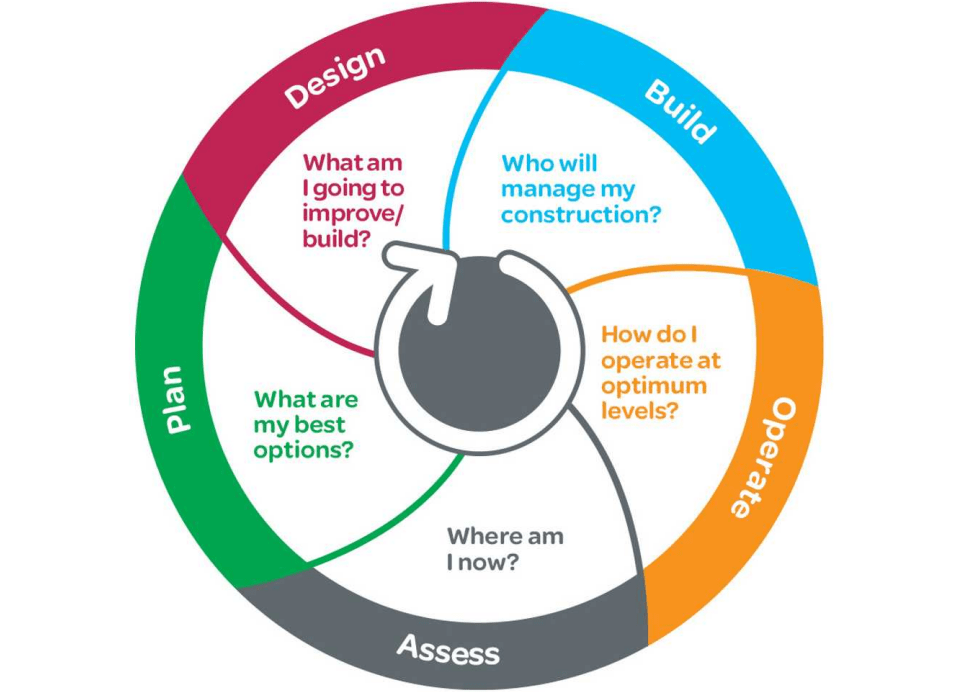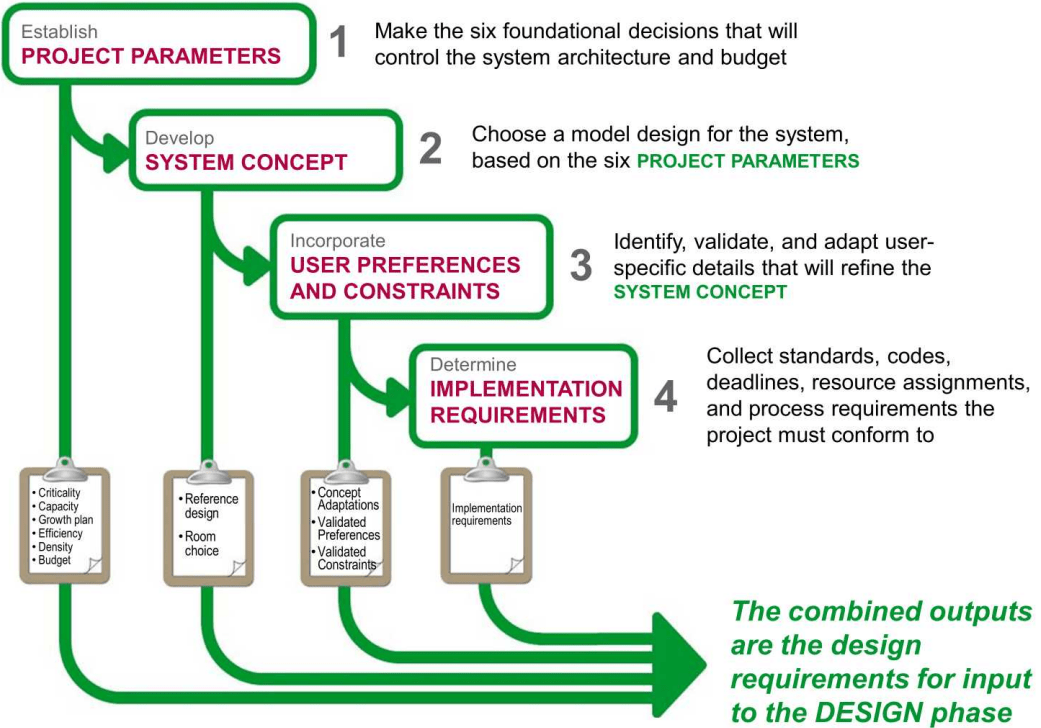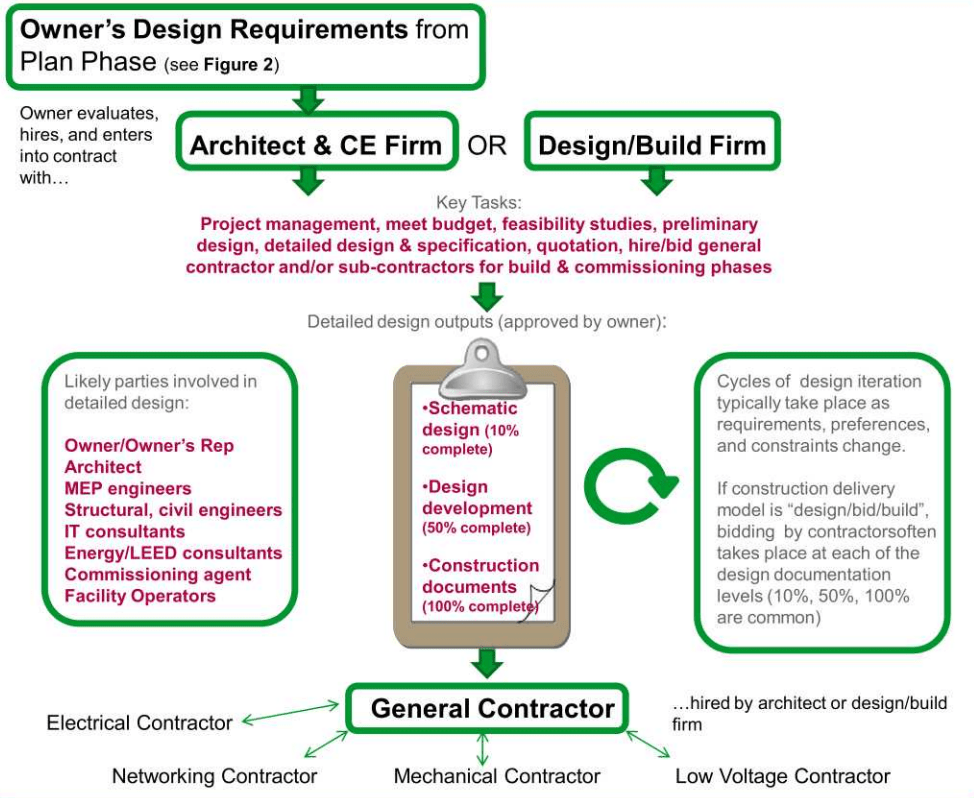
Even with the best-built data centers, they still need proper care and action to be taken to ensure they continue to work at their best abilities. This care must be continuously reviewed and implemented to ensure your data center will meet the business needs of your company.
So what steps do you need to take proper care of your data center? Here we will highlight the five phases of the life cycle, identify key tasks and pitfalls, and provide you with practical advice.

Phase 1 – Plan
The planning phase, also known as ‘programming’, is the first phase to the data center life cycle. This phase will determine the key project parameters of the physical system you want to create. When organised and managed properly, the project will run smoothly, impacting both the cost and the capabilities of the future data center.
Dropped handoffs, ambiguous responsibility, misinformed decisions, and other errors in communication or execution are all factors that waste time, waste money, and cause defects within data center projects. These problems are usually due to a lack of an overarching, shared process to guide each party involved during the planning stages.
To avoid problems like these, a formal, standardized, and documented process is key. This process should be clear on who the key stakeholders are and who should be involved during decision-making and milestone approval. This process should include the following:
- Every activity necessary for the end result should be included in the process.
- Each step should have clearly defined inputs and outputs.
- Every output produced will be the input to another step or the final output of the project. No time or effort should be wasted on outputs that don’t contribute to the process or final outcome of the project.
- Every step involved should have clear ownership responsibility assigned to a team member.
- Every step should be linked to a prerequisite and subsequent steps through its inputs and outputs.
- Ensure there are functions in place on standby to deal with unplanned changes or defect corrections.
- The steps can be deleted to work appropriately for the project at hand.
- A web-based system should be available for all stakeholders to easily access shared documentation, data, and reports.
The System Planning Sequence

Common Planning Mistakes
1. Focus on CAPEX and not TCO.
2. Poor cost-to-build estimate
3. Improper design criteria
4. Choosing a site before the design criteria
5. Planning space before design criteria
6. Designing into a dead end
7. Misunderstanding PUE
8. Misunderstanding LEED
9. Overcomplicated designs
Often these problems can be avoided if…
- You give the right information to the right decision-makers in the right sequence.
- Focus on ensuring a shared understanding and consensus of these key project parameters: criticality, capacity, growth plan, efficiency, density, and budget.
- Validate and agree upon design requirements before any detailed design work is started.
Phase 2 – Design
The design phase involves creating a detailed design to translate the plan from phase one into detailed, site-specific schematics and buildable construction documents. These designs will need to be approved by the consulting firm engineers and the owner and then used for permitting by the governmental authorities-having-jurisdiction (AHJs).
During this phase, you will also need to evaluate your options for construction contractors and select the best fit for you.

| Design/Bid/Build | Design/Build |
| This is the traditional approach where contractors will bid throughout the design development to be responsible for construction. | The owner or architect will hire a team who will be responsible for both the design and the construction. |
| You will then select the contractor that you would like to work with based on the requirements they meet and the price they offer. | Selection is based on both merits and price, with the price being guaranteed. |
| PROS | PROS |
| • Costs can be lower if the design change orders are well controlled. | • Shortens the project schedule by months by eliminating the bidding process. |
| • You will typically have more choices from more vendors | • You are more likely to get the exact equipment, systems, and designs that you specify. |
| • Contractors being involved early on reduces the risk and the number of design iterations. | |
| • Creates close cooperation between designers and contractors. | |
| CONS | CONS |
| • The bidding process can potentially add months to your project schedule. | • Likely to be more expensive. |
When choosing a firm or contractor consider the following questions to help you make the best decision for you:
- How do partners or previous clients regard them?
- Is local, on-site support required or can the firm be located remotely?
- How knowledgeable are they about local code requirements and other regulations?
- How much previous experience do they have in building or designing data centers?
- Does their previous experience match the complexity of your project?
- What services do they offer? Do these services match the needs of your project?
- Are their services the best or most sufficient fit for your needs?
- Do they have the resources/skills available internally to manage the project?
- Will a separate construction manager need to be hired alongside them?
- Are they good listeners?
- Are they willing to design around your specific needs and preferences?
A key part of ensuring that the design phase runs smoothly is to ensure that you have the right people involved and focused on the right things. Here are the key participants within your project and their roles throughout this project:
| Owner | To define and agree upon criticality, capacity, growth plan, density, efficiency, and budget parameters that are key to the project. This should all be done in collaboration with MEP engineers, commissioning agents, facility operators, IT dept/consultants, and the architect. They should select the architect/CE firm or the design/build firm. Review and approve on-going design development and bidding processes. Ensure key project parameters are incorporated within the detailed design. Cooperate the architect or design/build firm to conduct site surveys and secure permits and licenses. |
| Architect | To design and manage the facilities infrastructure. Sometimes they may hire and manage the MEP engineers. Some may already have engineers on staff and will therefore manage the MEP design too. Manages and creates the structural design in conjunction with electrical and mechanical designs. Some architects will hire and manage the general contractors. |
| CE firm (MEP Engineers) | To create and then manage the detailed design documents needed for the electrical, mechanical, and IT systems. They will be responsible for ensuring designs and the build meet the key project parameters and don’t go over budget. Sometimes the CE firm will hire and manage the general contractor instead of the architect. Larger CE firms may also offer commissioning, and project/construction management services depending on their capacity. |
| IT Dept/Consultants | To define the specific IT requirements of a project, such as service delivery type/SLAs, server hardware, networking and storage bandwidth/hardware, and software/app requirements. The requirements set will then determine the requirements for the physical infrastructure. They should be involved in the physical infrastructure design and planning process to ensure the data center will have the power, cooling, and space resources required to meet the IT requirements. |
| Energy/LEED Consultants | To measure monitor, report, and/or advise on energy consumption. These specialist consultants manage and advise on how to make the facility LEED (Leadership in Energy & Environmental Design) certified. They will help to ensure the detailed design reflects the owner’s requirements for energy efficiency and environmental impact during the planning and design phases. The architect or design/build firm may already have this expertise in-house. |
| Comissioning Agent | To test and ensure that the installed systems and their communications perform and operate as they should. They may act independently or be a part of the CE or design/build firm. They will develop a time-sequenced, order-based, detailed program to test all the critical infrastructure systems during the plan and design phases. Ideally, these systems should be developed under the supervision of the CE firm designers. Collorative working during the early phases ensures a faster and smoother process throughout the project. |
| Facility Operations | To ensure the data center is optimised for efficient and reliable operation over a long-term basis. It is best to involve the staff who will be operating and maintaining the data center on a daily basis during the early phases. They will use their practical expertise to help advise upon and validate design choices. Early involvement during the project will allow the staff to effectively develop an Operations & Maintenance (O&M) program documentation and to develop the necessary operator training program. |
| General Contractor | To help validate, comment, or advise on architectural and MEP design choices. They can help give perspective on cost, time, permitting, and other regulatory or legal requirements. They are typically aware of a construction project towards the end of the design phase to then begin their portion of the construction work. |
| Sub-contractor(s) | To help identify and resolve design or construction-related problems with their specialty knowledge. They will have a direct contract with the general contractor to perform a specific part of the project work. Typical sub-contractors include electrical, mechanical, network, and low voltage specialists. They are usually selected late into the design phase or early in the construction phase. |
| Equipment Vendors | To design, manufacture, test, deliver, and often install/configure and maintain the equipment. During these early project phases, equipment vendors will create submittal documents that contain product specifications to bid on the project. The vendor will typically come in towards the end of the design phase or the beginning of the construction phase. If brought in earlier they can provide design advice, train operations staff, and help ensure that delivery deadlines are met. |
Phase 3 – Build.
Using the construction documents developed during the design phase, the build phase will involve bidding for contractors (if using the ‘design/bid/build model’), securing building permits, and building the data center at the chosen site. With the owner’s go-ahead, the design/build firm, architect, or general contractor will lead the construction team to begin the construction according to the project plan.
Quality assurances and audits should be performed and reported regularly throughout this process. The owner should focus on the status of the progress, quality performance, and identifying scheduling risks. To ensure the smooth and efficient progress of the build phase, the often should be:
- Reviewing and approving construction documents before the building process starts.
- Assistanting the construction team with the preparation and filing of necessary documents for approvals needed from AHJs.
- Reviewing and deciding upon proposed change orders.
- Regularly reviewing the progress and quality of the work by the construction team.
- Ensuring any owner-supplied equipment is delivered and installed within the allocated timeframe.
- Formally approve the construction project upon completion.
Comissioning
Commissioning (Cx) is a reliability science that is used to document and validate the results of the data center’s design and build process. Effective commissioning accounts for the complexity within data centers by testing and documenting the overall system’s response to various real-world scenarios.
This type of testing process serves as an effective insurance policy for ensuring the design and construction of your data center is up to scratch. Whilst this is up to the owner whether to have commissioning performed or not, it is highly recommended by professionals.
The build phase is only complete when
Phase 4 – Operate.
The operation phase is the longest and costliest part of the data center life cycle that can last up to 20 years. This is the time where your data center does what it is meant to do: house, power, cool, and secure your IT equipment! The infrastructure will need to continuously operate even as the equipment ages, gets serviced, or eventually parts get replaced. The running of your data center is mission-critical so it must continuously be maintained to ensure failure does not occur.
A properly designed, supported, and implemented O&M program, as created in the design phase, will minimize any risk, reduce costs, and even provide you with a competitive advantage. An O&M program will include environmental health and safety, personnel management, emergency preparedness & response, maintenance management, change management, documentation management, training, infrastructure management, quality management, energy management, financial management, and performance monitoring and review.
Phase 5 – Assess.
The access phase runs concurrently with the operating phase to monitor and evaluate operations to ensure they are running at top performance. Regular monitoring and assessments can help to uncover potential problems before they cause you any trouble, making your data center safer, more efficient, and more reliable.
Assessing the performance of your data center is easily done through the use of key performance indicators to provide you with focus and drive improvements. We recommend the following KPIS:
| • Critical load uptime | • Load redundancy maintained | • Support system uptime |
| • Maintenance completition | • Staffing coverage | • Security policy conformance |
| • Emergency preparedness drills | • Emergency response procedure adherence | • Safety policy and procedure adherence |
| • Procedure development management & use | • Quality control/improvement | • Training compliance |
| • Process improvement | • Operational reporting | • Proper event notification & escalation |
| • Timely and accurate cost reporting |

For additional help or support with anything mentioned in this blog, or any other products that we stock, don’t hesitate to contact our team! Use our contact form to get in touch and our team will get back to you quickly with our expert knowledge!
This is just a brief look at the APC Range, if you require more Schneider Electric equipment for your business, you can check our Schneider Electric microsite for a wide range of APC products to suit your needs.
Other Schneider Electric products Available from Comms Express:
Server Racks & Accessories | NetBotz Security and Environmental Monitoring | Extended Warranty | Accessory Extended Warranty | Power Distribution Units | Uniterruptible Power Supply
If you require any further information on these or any other products that we stock here at Comms Express, please do not hesitate to contact our team who will be only too happy to help.
Until next time…
